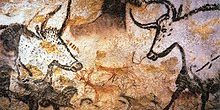Can art exist apart from color? Thank goodness that’s never been a predicament humankind has encountered. Art across the ages has been intermingled with glorious color.
“Color in art is as old as the cave paintings at Lascaux. Yet as an element in media as diverse as film, television, and photography, you can measure its ubiquity and preeminence in decades,” stated a contributor to the Boston Globe.
What color has the most profound impact on you personally?
3 Amazing Facts About the Cave Paintings at Lascaux
Each and every work of art boasts different types of color. Sometimes the color combinations make sense to viewers and sometimes they don’t. Still, there is always a reason artists choose specific color schemes.
The cave paintings at Lascaux have an amazing story as well as a beautiful color scheme. Here are a few fun facts about the paintings at Lascaux:
- They were rendered about 20,000 years ago (around 17,000 BCE) in a complex of caves in southwestern France in the Dordogne region.
- They were not discovered until 1940.
- The Stone Age artists painted about 2,000 figures (mostly animals native to the region) in the complex of caves at Lascaux. Human figures and abstract signs are also included in this number.
The Color Scheme of the Cave Paintings at Lascaux
The color scheme of the cave paintings at Lascaux is earthy, enduring, and warm. The prehistoric artists composed their artwork with the following pigments:
- Ochre
- Umber
- Sienna
- Manganese
- Kaolin
These pigments were used in most Stone Age art, and their components were sourced locally.
How Were the Cave Paintings at Lascaux’s Pigments Created?
The color pigments for the cave paintings at Lascaux were comprised of a variety of materials. The article Prehistoric Colour Palette explained,

Via Wikipedia.org
“Depiction of aurochs, horses, and deer”
“Stone Age artists relied on several different types of material to make the colour for their painting. Clay ochre was the main pigment and provided three basic colours: yellow, brown and numerous hues of red. For black pigment, artists typically employed either manganese dioxide or charcoal, or burnt bones (known as bone black).
For white pigment, they used kaolin or ground calcite (lime white). These colourants were first ground up to powder (using animal shoulder bones as mortars), then mixed with cave water (high in calcium carbonate) vegetable juice, animal fats, blood, bone marrow, albumen, and urine to help it adhere to the cave wall.
In addition, they used extenders like feldspar and biotite, or ground quartz and calcium phosphate (from crushed animal bone), in order to save on the pigment, to make the paint adhere more firmly to the cave wall and to prevent the paint from cracking when drying.”
The artists of the cave paintings at Lascaux were quite limited in their choice of color for the paintings. They certainly put their options to good use, expressing their culture and gifting the world with a huge body of artwork that will never cease to be studied and to stun learners.
Read more Segmation blog posts about prehistoric art:
- Early Cave Art in Spain
- 3 of the Oldest Pieces of Art in the History of the World
- Evolution of Artists Colors
Be an Artist in 2 minutes with Segmation SegPlay® PC (see more details here)
SegPlay® Mobile available for Amazon Fire, iPhone, iPad, Android






